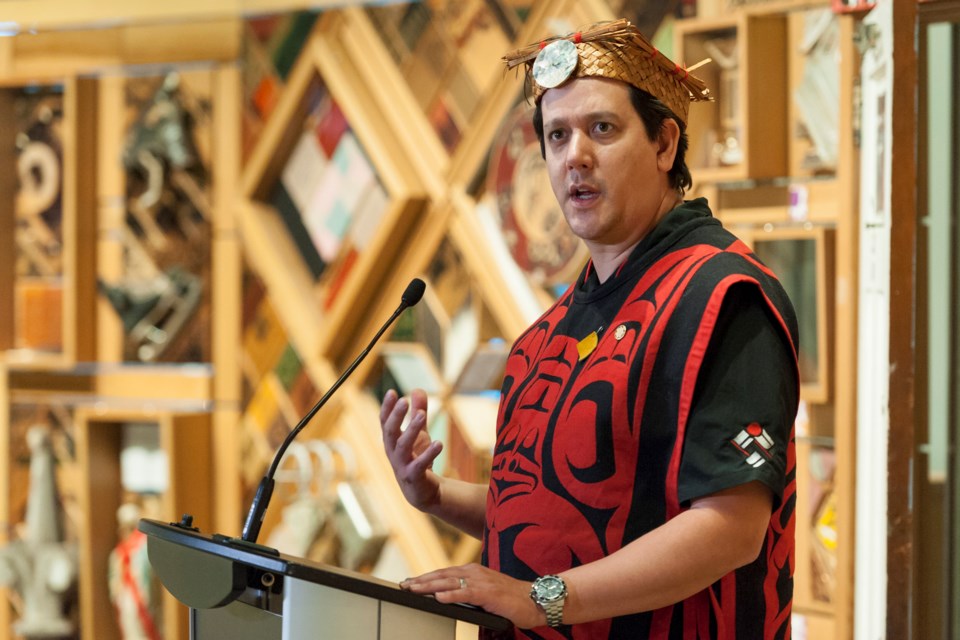One photograph shows a row of forlorn young girls standing in front of St Paul’s residential school in North Vancouver. Nearby, a vibrant Métis sash hangs. Above that, a selection of bricks taken from the edifices of residential schools across the country sit stacked upon one another. And in the centre, a wooden door that was once a gateway to a B.C. residential school’s infirmary.
Comprising more than 800 individual items collected from schools, survivors, churches, governments, and other cultural sites across Canada, the Witness Blanket is one of the largest and most confronting pieces of art to be inspired by the residential schooling system.
Now, more than a decade after it was first crafted by multidisciplinary artist Carey Newman, the eight-foot tall, 40-foot long piece is making its first appearance at the West Vancouver Memorial Library.
“When I saw this piece and learned about the subject matter, I knew it was something we had to display in some way or another,” said Taren Urquhart, West Vancouver Memorial Library’s arts and special events programmer.
Urquhart first came across the Witness Blanket at the Kelowna Art Gallery in 2021, one stop of a six-year long journey touring galleries, schools and centres across the country.
The piece is one of two replicas to be made of the original after years of travel brought damage to the first, which now sits preserved at the Canadian Museum for Human Rights in Winnipeg.
The replica is a photographic version of Newman’s original, with images printed onto wooden panels in lieu of the official artifacts. The three dimensional aspect of the piece might be lost, but the impact it has certainly hasn’t been, promises the artist.
“Think of it being like a print of an original painting, rather than the painting itself. The detail is all very clear, and the objects are just as moving, it’s just the texture that’s not there.”
Newman, whose traditional name is Hayalthkin’geme, started the project in 2012, yet for the first few months, “the going was pretty slow,” he said.
“When you describe this idea, a blanket made of objects, people don’t quite know what to make of it. It was really a process of building trust and building relationships.”
The sourcing of artifacts sat in a significantly different category to any work the artist had carried out before, he said.
“In this case I was taking things that were precious, that meant something to people, and that had stories already embedded or attached to them,” said Newman.
By spring 2014, Newman had secured 889 items from First Nations communities across the country. All hold significant value, he said, but some would prove to go on to impact the artist more than others.
There’s the small, weathered, child’s shoe, found on the grounds of the former Carcross Residential School in Carcross, that serves as a reminder to the artist of how the schooling system targeted the youngest and most vulnerable.
The two braids of hair, located in the left section of the sprawling artwork, were given to Newman by his sisters Ellen and Marion Newman.
Both had grown their hair long, braided it, and had it cut off in a traditional ceremony to honour their father, Victor, a residential school survivor, and the countless other Indigenous children who were stripped of their personal and cultural identities via the cutting of their hair.
“It’s significant because that’s my family, it’s about my father, but in a broader context it represents that same thing for so many people. That was the experience of so many children when they began these schools,” said Newman.
Newman said he had been aware of his father’s time in the residential schooling system, but had known little of the finer details of his experience prior to the creation of the Witness Blanket.
“As we went through it, he became more open about sharing the things that he experienced with me and my sisters. It brought us together and helped us better understand ourselves,” he said.
Newman said he was struck by the similarities between his own father’s experience and those of the countless survivors he had spoken with across the country, despite them having taken place thousands of miles apart.
“It really hit home just how clearly organized residential schools were, how intentional they were, from the design of the building, to experiences like the cutting of people’s hair and the restriction of language. That happened time and time and time again,” he said.
Newman will speak on such stories and the making of the Witness Blanket during a talk at the library Feb. 8, from 6:30 p.m. to 7:30 p.m. A screening of Picking Up the Pieces: The Making of the Witness Blanket, a behind the scenes look at the project, will take place at the library Feb. 17.
Newman’s piece will debut at the library Jan. 26, following a welcoming and blessing with Sḵwx̱wú7mesh Úxwumixw (Squamish Nation) Chepximiya Siyam’ Chief Janice George.
Mina Kerr-Lazenby is the North Shore News’ Indigenous and civic affairs reporter. This reporting beat is made possible by the Local Journalism Initiative.



